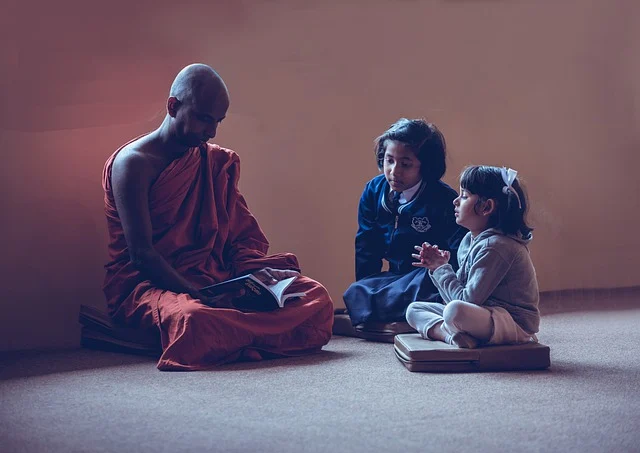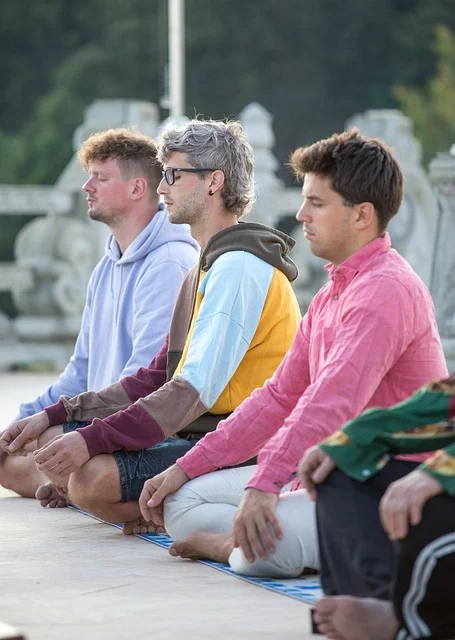Table of Contents

Introduction
In the ever-evolving landscape of human consciousness and well-being, mindfulness has emerged as a beacon of peace and clarity that transcends cultural and geographical boundaries. The term “mindfulness” is deeply rooted in ancient practices that have been preserved and transmitted through generations, but its relevance in contemporary society is more pronounced than ever before. Over the past few decades, mindfulness has gained unprecedented global recognition as a practice that enhances mental, emotional, and physical health.
Originating from Eastern spiritual traditions, it has transformed into a universal tool adopted and adapted by diverse cultures worldwide. This blog post embarks on a journey through the origins, evolution, and modern applications of mindfulness, offering a nuanced perspective on the ways it has been integrated into various cultural contexts. We will explore how mindfulness is practiced in different regions, the challenges of maintaining authenticity in a globalized world, and the profound impact it has on personal and societal well-being.
The Origins of Mindfulness: Eastern Traditions
Mindfulness, as we understand it today, is intrinsically linked to Eastern spiritual traditions. Its earliest documented origins can be traced back to Buddhism, particularly within the Theravāda tradition, which emphasizes the concept of sati, or mindfulness. The practice is central to the Eightfold Path, which serves as the ethical and meditative framework for Buddhist practice. Through mindfulness, individuals are encouraged to develop a heightened awareness of their thoughts, emotions, and actions. This heightened awareness is not merely an intellectual exercise but a transformative experience that leads to a deeper understanding of the nature of reality and the cessation of suffering.
Vipassana Meditation, which has its roots in Buddhism, is one of the most prominent mindfulness practices. It involves the systematic observation of sensations and thoughts, which in turn fosters clarity and equanimity. The ultimate aim of Vipassana is to achieve insight into the three universal characteristics of existence: impermanence (anicca), suffering (dukkha), and non-self (anatta). This practice has been instrumental in the global spread of mindfulness as a secular tool for personal development and stress reduction.
Another significant source of mindfulness practices is Hinduism, which predates Buddhism. The Bhagavad Gita, a sacred Hindu text, espoused the importance of mindfulness as a means to align one’s actions with a higher purpose and achieve spiritual liberation. Within Hindu traditions, meditation, known as dhyana, is a key component of spiritual practice. Moreover, the physical practice of yoga, particularly its emphasis on asanas (postures) and pranayama (breath control), is deeply intertwined with mindfulness. Yoga postures are designed to create a harmonious balance between the mind and body, fostering an environment conducive to meditation and inner awareness.
Taoism, a Chinese philosophy, also embraces mindfulness in its teachings. The essence of Taoist thought lies in living harmoniously with the Tao, the natural order of the universe. Practices such as Qigong and Tai Chi, which involve intentional movement and conscious breathing, embody mindfulness principles. These practices are not just physical exercises; they are a way of being that encourages practitioners to be fully present and in tune with their inner selves and the external world.
The Globalization of Mindfulness
The West’s fascination with mindfulness can be largely attributed to the efforts of spiritual teachers and scholars who brought these ancient practices to Western audiences in the 20th century. Notable among them are Thích Nhất Hạnh, a Vietnamese Buddhist monk, and Jon Kabat-Zinn, who developed the Mindfulness-Based Stress Reduction (MBSR) program. MBSR has been a catalyst for integrating mindfulness into Western culture, framing it in a secular, evidence-based context that has made it accessible to a broad spectrum of individuals.
Mindfulness has found a significant place in the realm of healthcare, particularly in the treatment of stress, chronic pain, and various mental health disorders. The MBSR program is widely employed in hospitals and clinics as a complementary approach to traditional medical treatments. It has been shown to improve patients’ quality of life and reduce the severity of symptoms associated with conditions such as anxiety, depression, and post-traumatic stress disorder (PTSD).
Education is another area where mindfulness has made significant inroads. Schools in Europe and North America are increasingly adopting mindfulness programs to help students manage stress and develop emotional intelligence. These initiatives are aimed at equipping the next generation with skills that can enhance their focus, empathy, and overall well-being.


The Role of Science in Mindfulness
The rise of mindfulness in the West has been fueled by a growing body of scientific research that validates its efficacy. Neuroscientific studies have employed functional MRI technology to observe the effects of mindfulness on the brain. These studies have demonstrated that mindfulness practices can lead to structural changes in the brain, particularly in the prefrontal cortex, which is associated with attention, self-regulation, and emotional regulation. Moreover, mindfulness has been shown to reduce activity in the amygdala, a region associated with stress and the fight-or-flight response.
Psychological research has also played a critical role in the global spread of mindfulness. It has provided empirical evidence for its benefits in various domains of mental health, including reducing symptoms of depression and anxiety and enhancing resilience and overall psychological well-being. This scientific validation has not only increased the credibility of mindfulness but also paved the way for its integration into mainstream healthcare and educational systems.
Regional Trends in Mindfulness Practices
4.1. Asia: Tradition Meets Technology
In Asia, the birthplace of mindfulness, traditional practices continue to coexist with and often inspire modern innovations. In India, for example, mindfulness is a cornerstone of spiritual retreats and yoga tourism, which attracts individuals from around the world seeking a deeper connection with their inner selves. The country is also at the forefront of integrating mindfulness into various aspects of daily life, including healthcare, education, and business.
Japan has embraced Zen mindfulness, incorporating its principles into corporate culture. Japanese companies have recognized the potential of mindfulness in improving employee productivity and well-being, leading to the development of corporate mindfulness programs that draw from Zen philosophy and practice.
China, on the other hand, has seen the rise of technology-enhanced mindfulness. Ancient practices like meditation and Qigong are now being taught and practiced through mobile apps, making them more accessible to a younger, tech-savvy generation. These apps are designed to align with modern lifestyles, offering bite-sized sessions that can be integrated into busy schedules.
4.2. Western Countries: Secular and Therapeutic Approaches
In contrast to Asia, Western countries have largely secularized mindfulness, focusing on its practical applications in stress reduction, mental health, and productivity. The spiritual roots of mindfulness have often been set aside to appeal to a more diverse audience, which includes individuals from various religious backgrounds or those with no spiritual inclinations. Mindfulness is commonly offered as a standalone practice or integrated into psychotherapy, stress management programs, and self-help courses.
Europe and North America have witnessed a surge in the popularity of mindfulness, with a plethora of books, workshops, and retreats available to the public. It has become a mainstream practice, with celebrities and corporate leaders advocating its benefits. However, this secularization has led to concerns about the potential dilution of the original essence of mindfulness.
4.3. Africa: Spiritual and Communal Dimensions
Mindfulness in Africa often retains its spiritual and communal dimensions, with practices deeply embedded in indigenous healing traditions. In many African societies, mindfulness is experienced collectively through rituals that involve drumming and storytelling. These communal practices serve not only to cultivate individual awareness but also to strengthen social bonds and heal collective trauma.
The use of mindfulness in trauma healing is particularly notable in post-conflict regions of Africa. Here, mindfulness is employed alongside traditional healing methods to help individuals and communities recover from the psychological scars of war and violence. It is a testament to the adaptability of mindfulness that it can be woven into the fabric of existing cultural practices to address specific societal challenges.
4.4. Latin America: A Syncretism of Traditions
Latin American mindfulness practices reflect a rich tapestry of indigenous, African, and European influences. The region has seen a unique blending of these traditions, resulting in practices that are both deeply rooted and innovative. Mindfulness in Latin America is often imbued with spirituality, drawing from indigenous wisdom and Christian contemplative practices.
In social justice movements, mindfulness serves as a tool for fostering resilience and compassion among activists. It is also integrated into community-centered healing ceremonies, highlighting the interconnectedness between individuals and their environment.
4.5. Middle East: Emerging Practices
In the Middle East, where Islam is the predominant religion, mindfulness is aligned with the concept of Tafakkur, or contemplation. As the region grapples with the aftermath of conflict and seeks peace-building initiatives, mindfulness is being recognized for its potential in this area. Emerging trends include the use of mindfulness in addressing collective trauma and promoting reconciliation.


Cross-Cultural Comparisons of Mindfulness Practices
5.1. Diverse Techniques
While the core essence of mindfulness remains consistent across cultures, the techniques employed to achieve this state of being vary widely. In Asian traditions, the emphasis is often on seated meditation and specific breathing practices. In contrast, Western approaches frequently utilize structured programs like MBSR, which provide a more systematic and goal-oriented path to mindfulness.
African practices, meanwhile, may incorporate storytelling and communal rituals that engage participants in a shared mindfulness experience. Each cultural expression of mindfulness is a reflection of its historical and societal context, offering a unique lens through which to understand and experience the present moment.
5.2. Adaptation vs. Authenticity
As mindfulness becomes increasingly globalized, the tension between cultural adaptation and authenticity arises. While adapting practices to local contexts ensures relevance and accessibility, it can also lead to concerns about the dilution of the original teachings. The commercialization of mindfulness, as seen in the proliferation of mindfulness apps and products, has sparked debates about whether the essence of these practices is being preserved or if they are merely being repackaged to cater to a market-driven society.
Modern Trends in Mindfulness Practices
6.1. Technology and Mindfulness
The digital age has given rise to a multitude of mindfulness tools that leverage technology to enhance practice. Mindfulness apps such as Headspace and Calm have become wildly popular, offering guided meditations, stress management techniques, and mindfulness exercises to millions of users. Additionally, wearable devices are now equipped to track stress levels and provide personalized mindfulness interventions throughout the day.
Virtual reality (VR) is another emerging technology that is being harnessed to create immersive meditation experiences. VR can transport practitioners to serene environments, providing a powerful visual and auditory backdrop to deepen their practice. These innovations are making mindfulness more accessible and appealing to those who may find traditional methods less engaging or intimidating.
6.2. Workplace Mindfulness
In the fast-paced world of corporate culture, mindfulness has found a new home in the office. Companies like Google and SAP have introduced mindfulness programs to boost employee productivity, creativity, and overall well-being. These initiatives aim to foster a more mindful workforce that is better equipped to handle stress, improve focus, and work harmoniously with others.
6.3. Mindfulness in Education
Schools worldwide are recognizing the importance of mindfulness in fostering a positive learning environment. By integrating mindfulness into the curriculum, educators seek to improve students’ focus, emotional intelligence, and social skills. Programs such as Mindful Schools in the United States and Mindfulness in Schools in the United Kingdom are leading the way in this movement, providing resources and training for teachers to bring these practices into the classroom.
The Science Behind Mindfulness Across Cultures
7.1. Neuroscience Discoveries
Neuroscientific research has yielded fascinating insights into the workings of mindfulness. Studies have shown that regular practice can lead to increased gray matter density in the prefrontal cortex, hippocampus, and other regions associated with learning, memory, and emotional regulation. Additionally, mindfulness has been found to reduce gray matter volume in the amygdala, which is linked to stress and fear responses.
These neuroplastic changes suggest that mindfulness can have a lasting impact on cognitive and emotional functioning, contributing to a more resilient and emotionally balanced state of being.
7.2. Culturally Specific Outcomes
Research also indicates that the effectiveness of mindfulness may be influenced by cultural beliefs and values. For instance, in collectivist societies, mindfulness practices might be more effective when they emphasize interconnectedness and social harmony. In contrast, individualistic cultures might respond better to practices that focus on personal growth and self-actualization. This underscores the importance of tailoring mindfulness interventions to the cultural context in which they are applied.
Critiques and Controversies
8.1. Commercialization
The commercialization of mindfulness has led to concerns about the commodification of spiritual practices. As mindfulness becomes a billion-dollar industry, there is a risk that the depth and integrity of these practices may be compromised in favor of profit. This commercialization can result in superficial engagement and a dilution of the original teachings, which emphasize ethical living and compassion.
8.2. Appropriation vs. Appreciation
The adoption of mindfulness by Western cultures has also raised questions about cultural appropriation. Some argue that Western practices often strip away the spiritual and ethical dimensions of mindfulness, misrepresenting or even exploiting Eastern traditions for commercial gain. It is essential to approach these practices with respect and an understanding of their historical context.
8.3. Cultural Sensitivities
The integration of mindfulness into non-Western cultures must be handled with cultural sensitivity. Care must be taken to avoid imposing external values or undermining local traditions. Instead, efforts should be made to build bridges between different cultural perspectives and practices, fostering a dialogue that honors the wisdom of each tradition.
The Future of Mindfulness Practices Across Cultures
9.1. Predictions
Looking ahead, we can anticipate further integration of mindfulness with technology, as advancements in artificial intelligence and virtual reality offer new ways to support and enhance practice. Additionally, mindfulness is likely to become increasingly embedded in healthcare and educational settings, with a growing body of evidence supporting its benefits.
9.2. Global Influence
As mindfulness evolves, it will continue to be shaped by global trends while maintaining a strong connection to local cultures. We can expect to see a proliferation of culturally tailored mindfulness programs that respect and incorporate traditional practices.


Conclusion
The journey of mindfulness from its ancient Eastern roots to its current status as a global phenomenon is a testament to the universal appeal of its core principles: being present and cultivating compassion. As we continue to explore and adapt these practices to meet the diverse needs of modern society, it is crucial to remain grounded in cultural sensitivity and respect. By doing so, we can ensure that mindfulness remains a powerful tool for fostering well-being and understanding across the globe.
The future of mindfulness lies in its capacity to adapt and evolve, blending ancient wisdom with contemporary insights. As it weaves its way through different cultures, it has the potential to create a more interconnected and empathetic world. The challenge for practitioners and educators is to balance the desire for innovation with the need to preserve the integrity of these practices, ensuring that the essence of mindfulness remains intact.
In conclusion, mindfulness has transcended its origins to become a universal language of presence and compassion. Its global embrace underscores the fundamental human need for inner peace and self-awareness. As we navigate the complexities of an interconnected world, mindfulness serves as a reminder of our shared humanity and the power of intentionally cultivating a more mindful existence. Through its various forms and applications, it has the potential to enrich our lives and contribute to a more harmonious global community.
Trends in Mindfulness Practices Trends in Mindfulness Practices Trends in Mindfulness Practices Trends in Mindfulness Practices Trends in Mindfulness Practices Trends in Mindfulness Practices Trends in MindfTrends in Mindfulness PracticesTrends in Mindfulness Practices Trends in Mindfulness Practices Trends in Mindfulness Practices Trends in Mindfulness Practices Trends in Mindfulness Practices Trends in Mindfulness Practices Trends in Mindfulness Practices Trends in Mindfulness Practices Trends in Mindfulness Practices Trends in Mindfulness Practices Trends in Mindfulness Practices Trends in Mindfulness Practicesulness Practices Trends in Mindfulness Practices Trends in Mindfulness Practices Trends in Mindfulness Practices Trends in Mindfulness Practices Trends in Mindfulness Practices Trends in Mindfulness Practices Trends in Mindfulness Practices Trends in Mindfulness Practices